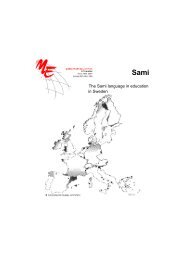Multilingual Early Language Transmission (MELT) - Mercator ...
Multilingual Early Language Transmission (MELT) - Mercator ...
Multilingual Early Language Transmission (MELT) - Mercator ...
Create successful ePaper yourself
Turn your PDF publications into a flip-book with our unique Google optimized e-Paper software.
agreed with each other, they are telling stories, singing songs and playing games with the<br />
children in the minority language.<br />
5.2 Results of implementing the <strong>MELT</strong> Guide into pre-schools<br />
5.2.1 Process of implementing the <strong>MELT</strong> Guide<br />
During the school year 2010-2011, several practitioners (about 40 practitioners per region,<br />
120 in total) of 40 different provisions in the four regions implemented the first draft version<br />
of the <strong>MELT</strong> toolkit within their settings to improve their skills and help them to be more<br />
aware of creating a language strategy within their day care. This toolkit offers guidelines,<br />
practical examples, lesson plans and theory that is aimed at language development of<br />
children aged 0-4 years.<br />
The <strong>MELT</strong> project tutors visited the participating pre-school settings 5 times, in order to<br />
guide and assist the practitioners. During the <strong>MELT</strong> project the use and content of the toolkit<br />
was evaluated on a block by block basis. Several evaluation periods were organised;<br />
discussion groups during expert seminars, monthly Skype Meetings, contact through<br />
electronic mail and evaluation forms.<br />
Following feedback received from the final evaluation period between all four tutors during<br />
a Skype meeting in May 2011, the <strong>MELT</strong> partners agreed on updating and editing the toolkit<br />
into a Guide. The original draft consisted of five sections, with the final version including nine<br />
sections. The Guide is written as a common tool for all practitioners within a pre-school<br />
setting, with the aim of assisting them to work towards a focused language strategy within<br />
their day care. However, the Guide can also serve as a practical tool for beginners. These<br />
changes included presenting the Guide as a binding folder with all sections presented<br />
bilingually on each page. It became evident during the tutor visits that many practitioners<br />
are learning the minority language themselves. Due to this, it was decided that the two<br />
languages (the minority and majority language) would appear on the same side. This will<br />
enable practitioners to see both languages at the same time, hopefully assisting them in the<br />
learning process. By restructuring the <strong>MELT</strong> Guide, pre-school teachers will feel encouraged<br />
to use these sections in their own way, and in any order which they deem appropriate to<br />
their actual setting of learning and teaching. The final Guide will be translated into eight<br />
languages which will be available online and in hard copy from October 2011.<br />
5.2.2 Results of implementing the <strong>MELT</strong> Guide<br />
According to the four tutors 108 within the <strong>MELT</strong> project, the most important and challenging<br />
tasks was promoting the benefits of bilingualism and raising awareness of minority language<br />
108 The four tutors of the <strong>MELT</strong> project are: Johanna Sallinen (Swedish community in Finland); Margaret Francis (Wales); Virginie Pronost<br />
(Brittany) and Sytske de Boer (Fryslân). Further descriptions of the tutors and organisations are at the <strong>MELT</strong> website: www.meltproject.eu<br />
[Accessed August 2011].<br />
72



